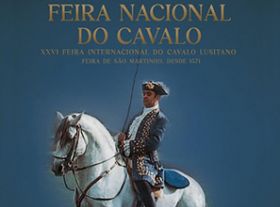Igreja Matriz ou de Nossa Senhora da Conceição
Igreja Matriz ou de Nossa Senhora da Conceição
Monuments
Golegã Parish Church is situated in the city´s main square and is dedicated to Our Lady of the Conception. The exact date of its construction is not known, but there is no doubt that the building work, originally begun in the early 16th century, marked a historical period of great development in the region, which can be attributed to the preference shown by the king D. Manuel.
Although the structure exhibits a certain continuity in the use of the mendicant Gothic style, some features show that there was a definite building programme relating to the use of Manueline iconography. This is visible in the stellar vaults in the chancel and in the decorative elements of the triumphal arch, the church´s side doors and the main entrance, which is perhaps the most important example of the use of the new artistic language.
The church´s spiritual space is heralded by the exuberant decoration of the doorway, enlivened by the various symbols of the Manueline art: the eucharistic vine, the artichokes of the Resurrection, the Crosses of the Order of Christ, the rope motifs, the twisted side columns and the decorative tracery of the frieze. In the centre of this composition, we can see an image of the Virgin Mary. The overall effect is further enhanced by the royal arms and armillary spheres placed in the upper bull´s eye window, underlining the royal protection afforded by D. Manuel I. The beautiful doorway has been attributed to Diogo Boitaca (c. 1510-1515), one of the great master builders of the time, whose highly regarded work was to be found in many of the kingdom´s most important cities, as for example the Mosteiro dos Jerónimos in Lisbon, the Mosteiro de Santa Cruz in Coimbra or the Convento de Jesus in Setúbal.
Inside the church, the decoration of the altars and the staircase leading to the tower and the azulejos in the chancel are all later additions from the 18th century. The church underwent restoration work during the course of the 19th century, when it was given a certain revivalist style, and in the mid-20th century.
In front of the church, you should stop awhile to appreciate the Pillory of Golegã, simply decorated with a bell-shaped top, which also dates from the 16th century. It is believed to have been built when D. João III raised Golegã to the status of a town in 1534.
Although the structure exhibits a certain continuity in the use of the mendicant Gothic style, some features show that there was a definite building programme relating to the use of Manueline iconography. This is visible in the stellar vaults in the chancel and in the decorative elements of the triumphal arch, the church´s side doors and the main entrance, which is perhaps the most important example of the use of the new artistic language.
The church´s spiritual space is heralded by the exuberant decoration of the doorway, enlivened by the various symbols of the Manueline art: the eucharistic vine, the artichokes of the Resurrection, the Crosses of the Order of Christ, the rope motifs, the twisted side columns and the decorative tracery of the frieze. In the centre of this composition, we can see an image of the Virgin Mary. The overall effect is further enhanced by the royal arms and armillary spheres placed in the upper bull´s eye window, underlining the royal protection afforded by D. Manuel I. The beautiful doorway has been attributed to Diogo Boitaca (c. 1510-1515), one of the great master builders of the time, whose highly regarded work was to be found in many of the kingdom´s most important cities, as for example the Mosteiro dos Jerónimos in Lisbon, the Mosteiro de Santa Cruz in Coimbra or the Convento de Jesus in Setúbal.
Inside the church, the decoration of the altars and the staircase leading to the tower and the azulejos in the chancel are all later additions from the 18th century. The church underwent restoration work during the course of the 19th century, when it was given a certain revivalist style, and in the mid-20th century.
In front of the church, you should stop awhile to appreciate the Pillory of Golegã, simply decorated with a bell-shaped top, which also dates from the 16th century. It is believed to have been built when D. João III raised Golegã to the status of a town in 1534.
Contacts
Address:
Largo da Imaculada Conceição 2150-125 Golegã
Telephone:
+351 249 976 193




 Explore
Explore 
 Remember and Share
Remember and Share 


